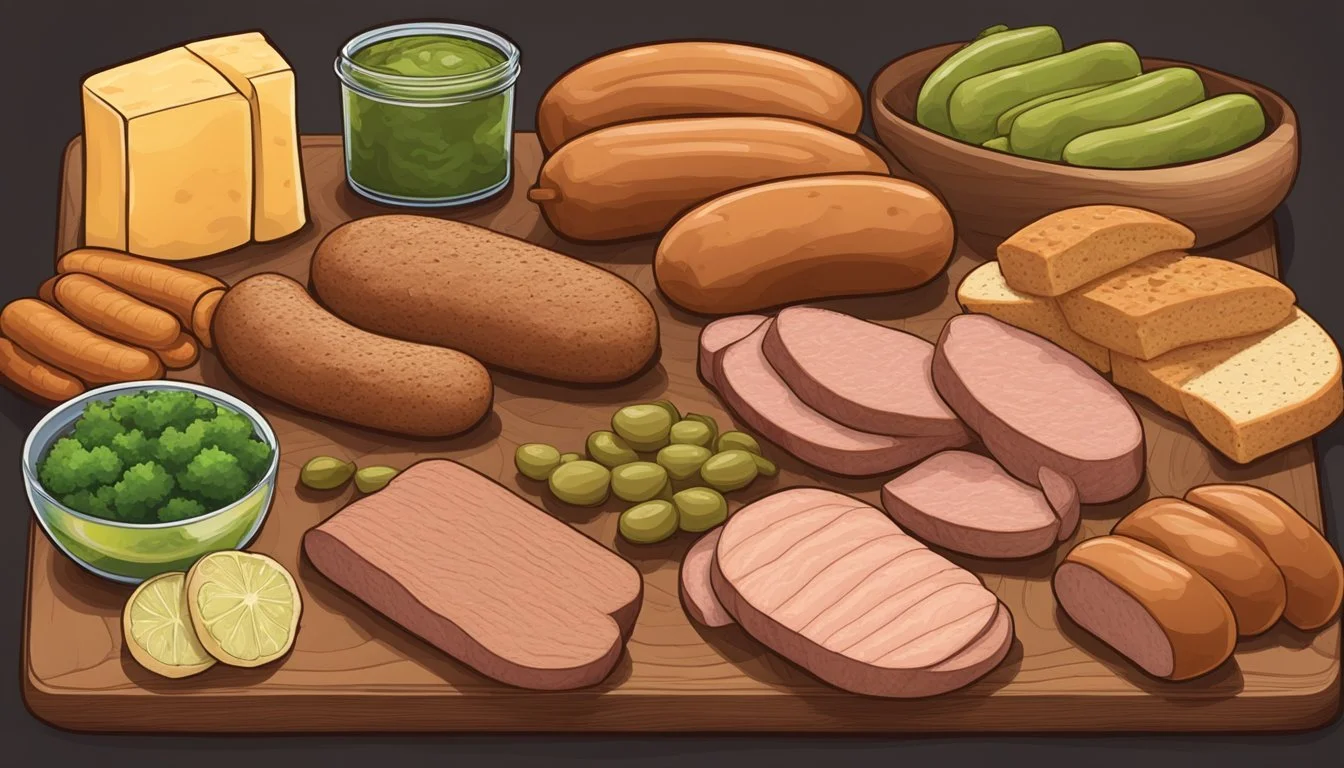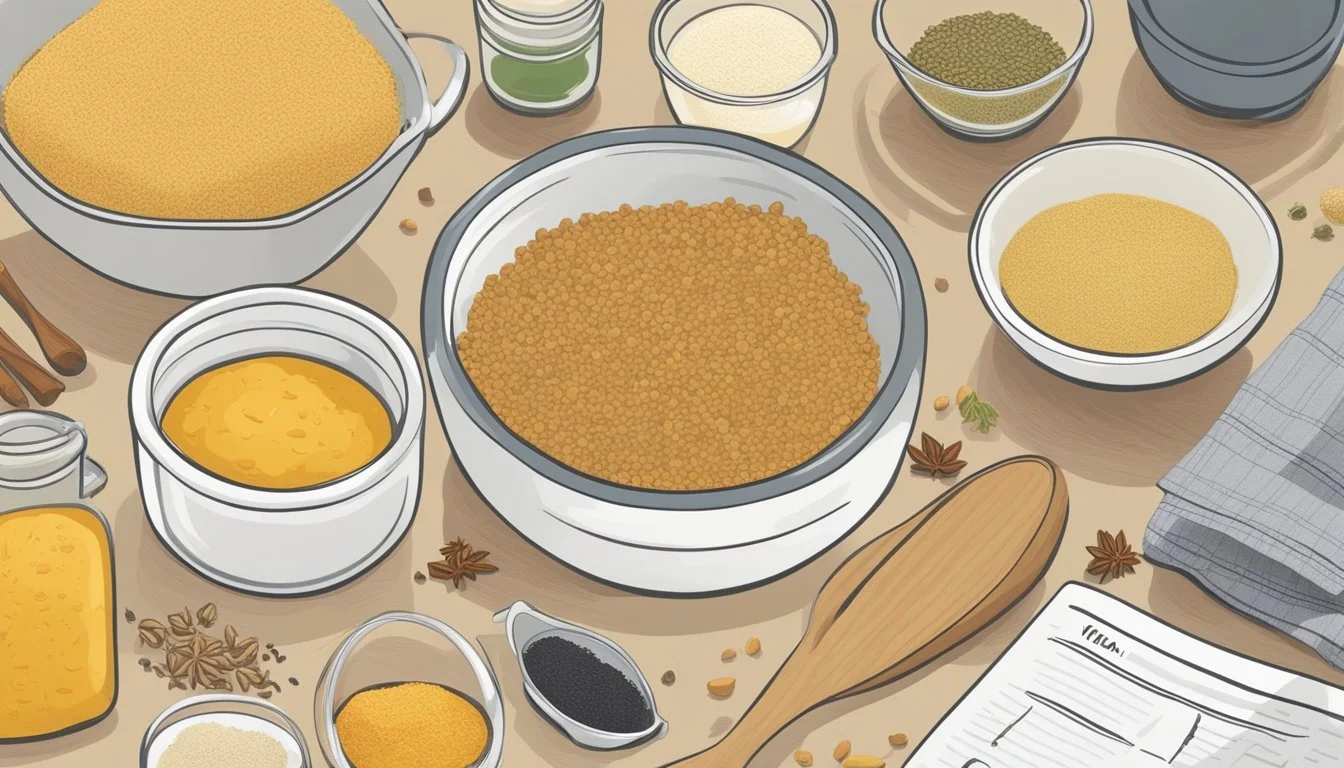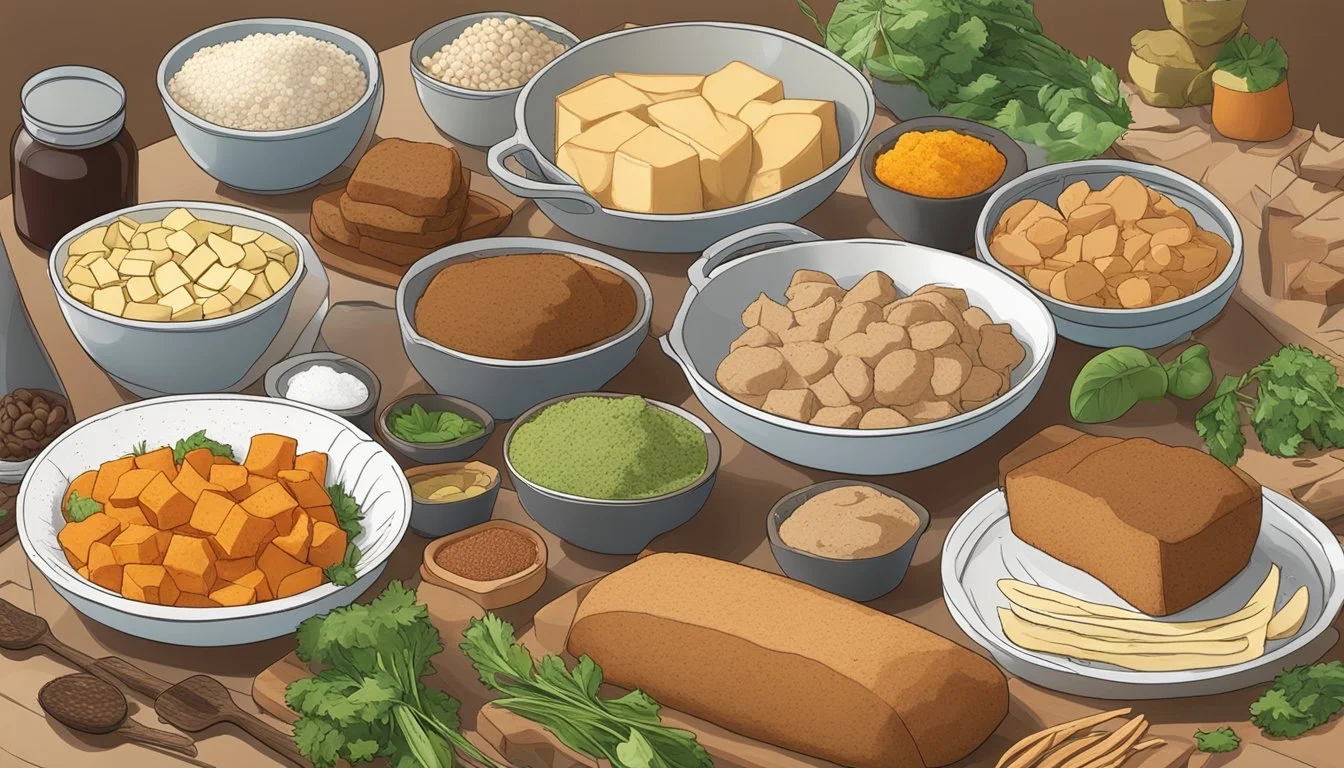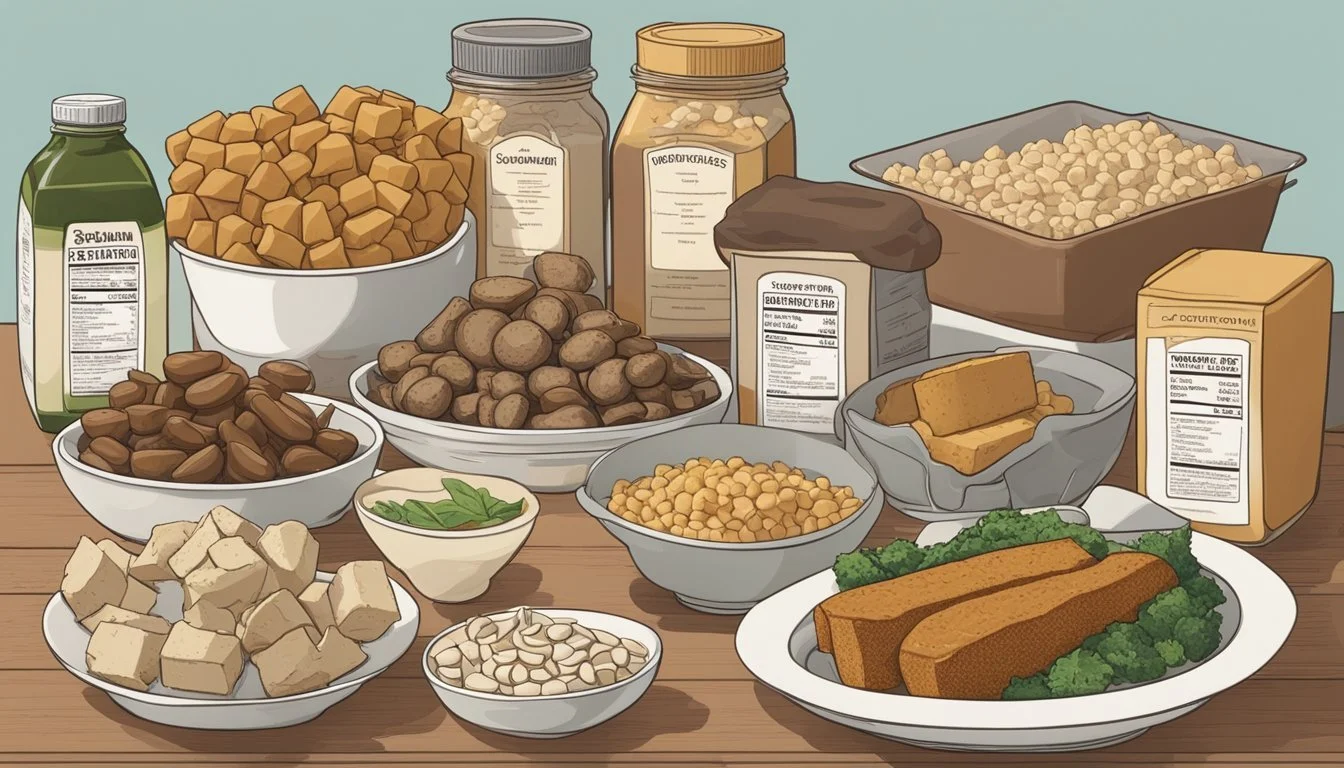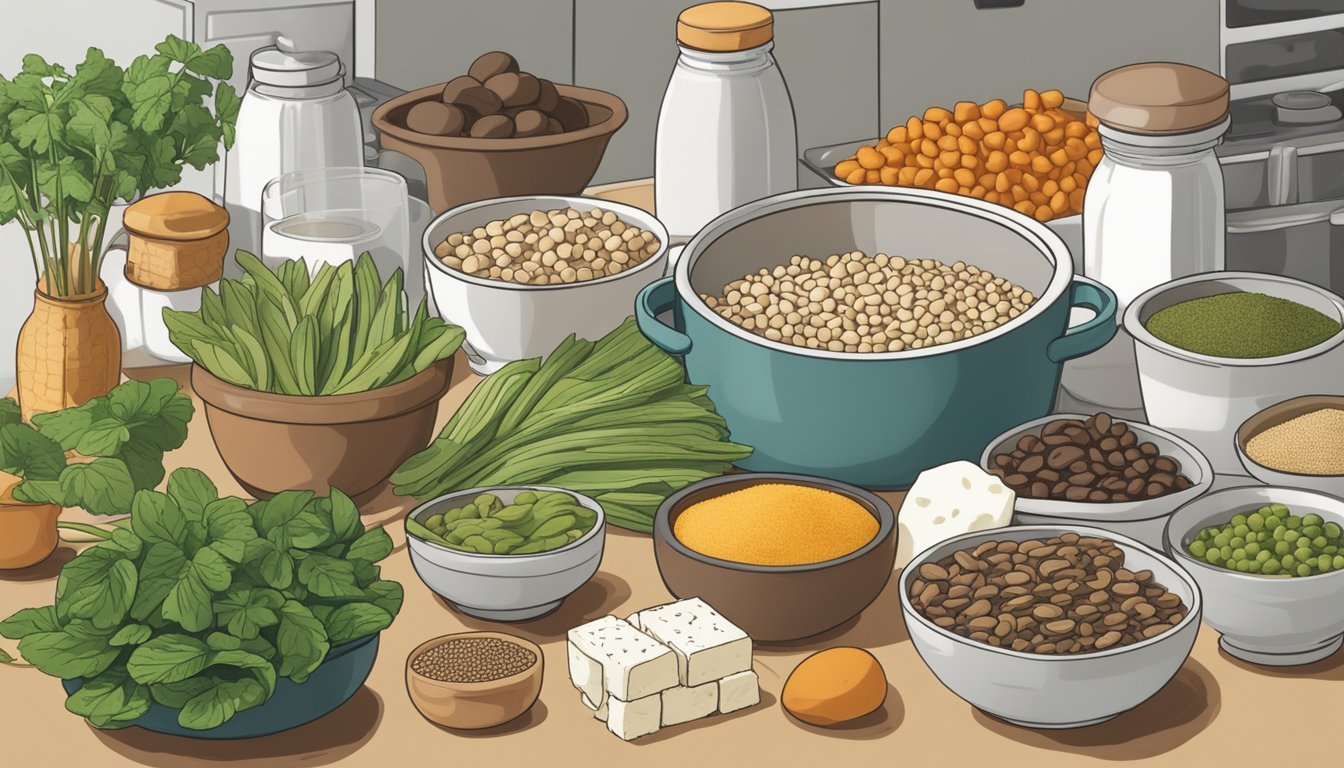Seitan Substitutes
Top Plant-Based Protein Alternatives
Seitan, often hailed as a versatile and protein-rich meat alternative, has entrenched itself in vegan and vegetarian cuisine. Predominantly made from wheat gluten, seitan possesses a chewy texture reminiscent of meat, which makes it a popular choice for those seeking to reduce or eliminate animal products from their diet. However, its reliance on wheat as the primary ingredient renders it unsuitable for individuals with gluten sensitivities or celiac disease, necessitating a need for gluten-free options.
To cater to a broader spectrum of dietary needs, the market has responded with a variety of seitan substitutes that maintain the spirit of a meat-like texture and flavor while steering clear of gluten. Among these alternatives, tofu and tempeh stand prominent, providing substantial protein content and a versatility that allows them to assimilate into countless dishes. Tofu, derived from soybeans, offers a milder taste and a range of consistencies from soft to extra firm, while tempeh, also soy-based, delivers a nuttier flavor and a heartier bite due to its whole-bean origin.
Expanding the selection, plant-based chicken, meat crumbles, and sausages are innovating the culinary scene, mimicking the taste profiles sought after by meat-eaters and vegans alike. In the same breath, natural foods such as jackfruit, mushrooms (What wine goes well with mushrooms?), lentils, and a variety of beans are praised for their adaptability in recipes traditionally dominated by seitan, adding not only substance but also a rich palette of flavors and textures that align with the integrity of a meat substitute.
Understanding Seitan
Seitan is derived from wheat gluten, the main protein found in wheat. Recognized for its high protein content, seitan stands out as a significant component in vegetarian and vegan diets.
Seitans's characteristic meaty texture is a primary reason for its popularity as a vegan meat substitute. Unlike other plant-based protein options like tofu or tempeh, seitan's texture is particularly dense, making it resemble the mouthfeel of meat more closely.
Recipe creation with seitan is versatile. It can mimic numerous meaty textures, from deli slices to ground crumbles, fitting a variety of culinary applications. However, due to its wheat origin, seitan is unsuitable for those with gluten sensitivities or celiac disease.
Despite its modern popularity, seitan is not a new invention. It has a historical presence, particularly in Asian cuisines, where it was commonly used by Buddhist monks.
In the table below, seitan's attributes are summarized:
Property Description Source Wheat gluten Protein High Texture Meat-like, dense Dietary Role Vegan meat substitute Recipe Flexibility High; adaptable to various dishes Allergens Contains gluten
In essence, seitan provides a substantial, versatile option for those seeking plant-based alternatives to meat without compromising on texture and protein content. Its longstanding use across various cultures testifies to its adaptability and culinary value.
Health and Nutrition
In evaluating substitutes for seitan, their nutritional profiles are pivotal. Each alternative brings a unique set of health benefits revolving around protein content, vitamins and minerals, dietary fiber, and caloric value.
Protein Content
Protein is crucial for muscle repair and hormonal regulation. Seitan is a high-protein food, akin to many meat sources. It is imperative to consider the protein content in seitan substitutes:
Tofu: A 100-gram serving of tofu offers about 8 grams of protein.
Tempeh: This soy product provides approximately 19 grams of protein per 100 grams.
Textured Vegetable Protein (TVP): A similar serving contains about 12 grams of protein.
Protein from plant-based sources often lacks one or more essential amino acids. This means they are not typically complete proteins, unlike animal-based proteins.
Vitamins and Minerals
Seitan and its substitutes contribute valuable vitamins and minerals to one's diet.
Tofu and Tempeh: Rich in iron and calcium; tofu also contains magnesium.
Lentils: Provide a good source of iron and B-vitamins.
Mushrooms: Offer B-vitamins and selenium, a mineral with antioxidant properties.
It's critical to compare the iron and calcium content in these foods as they are vital for blood health and bone strength respectively.
Dietary Fiber
Fiber supports digestive health and can influence cholesterol levels.
Legumes (lentils, beans): High in fiber with about 15 grams per cup.
Mushrooms: Lower in fiber compared to legumes but a helpful source for adding roughage.
Jackfruit: Contains a moderate amount of fiber useful in digestion.
Textured Vegetable Protein and seitan lack dietary fiber, making their alternatives particularly beneficial for those needing more fiber in their diets.
Caloric Value
The caloric value is an important consideration for those monitoring energy intake.
Seitan: Roughly 370 calories per 100 grams.
Tofu: Significantly lower at about 70-80 calories per 100 gram serving.
Mushrooms: Only 22 calories per 100 grams, making them a low-calorie substitute.
Choosing a substitute based on caloric needs can contribute to weight management and overall health maintenance.
Seitan and Food Allergies
Seitan is a popular meat substitute derived from gluten, the protein found in wheat. While it offers a high-protein option for many, it poses significant concerns for individuals with gluten-related allergies or intolerances.
Gluten Sensitivity
Gluten sensitivity manifests with symptoms similar to Celiac Disease—though not as severe—such as bloating, diarrhea, and abdominal pain. Seitan is a concentrated source of gluten, making it unsuitable for those with this condition. Alternatives for a gluten-sensitive diet include:
Tofu: a soy-based protein, versatile and gluten-free.
Jackfruit: a tropical fruit, often used for its meaty texture.
Celiac Disease
Celiac Disease is an autoimmune disorder where ingestion of gluten leads to damage in the small intestine. Consuming seitan can trigger severe health reactions in individuals with Celiac Disease. Gluten-free substitutions are important for their diet:
Gluten-Free Substitutes Description Lentils and beans Protein-rich legumes with a hearty feel. Textured vegetable protein (TVP) A processed product often made from soy, mimics the texture of meat.
Top Seitan Substitutes
When choosing a substitute for seitan, individuals often consider texture, protein content, and versatility in recipes. Here are some of the top alternatives.
Tofu and Tempeh
Tofu, derived from soybeans, is celebrated for its high protein content and its ability to absorb flavors, making it a versatile option in cooking. It can be silken, soft, firm, or extra-firm. Tempeh also hails from soybeans, but it boasts a nuttier flavor and a firmer texture. It's rich in protein and fiber and is a fitting choice for those transitioning from seitan.
Tofu uses: Suitable in soups, stews, marinades, and stir-fries.
Tempeh uses: Ideal in salads, sandwiches, and as a grilled protein.
Jackfruit
Jackfruit serves as a seitan alternative mainly due to its texture, which is akin to shredded meat. It's particularly popular in vegan and vegetarian cuisines for its ability to mimic the texture of pork or chicken in savory dishes.
Jackfruit uses: Excels in tacos, burritos, or as a pulled meat substitute.
Legumes and Beans
Legumes and beans like lentils, chickpeas, and black beans are excellent sources of protein. They have a hearty texture and a somewhat nutty flavor which can complement many dishes that usually contain seitan.
Lentils and beans uses: Work well in salads, soups, and as meaty fillers in dishes like veggie burgers.
Textured Vegetable Protein (TVP)
Textured Vegetable Protein (TVP) is a dehydrated soy product that is high in protein and mimics the texture of ground meat, making it a fitting seitan replacement in recipes.
TVP uses: Stands out in chili, tacos, and as a ground meat replacement in pasta sauces.
Substitute Versatility
Seitan substitutes offer a diverse range of textures and flavors suitable for various culinary applications, ensuring that dishes can maintain their integrity even when the original ingredient is substituted.
Cooking Applications
Substitutes for seitan can transform a dish with their diverse textural possibilities. Tofu is renowned for its adaptability; it can be pressed and drained to create firmer textures ideal for burgers and meatballs. It can also be crumbled to mimic ground meat in tacos or sliced for use in stir fry dishes.
Tempeh's firmness and nutty taste make it an exceptional choice for recipes requiring more bite, a perfect ingredient in both salads and hearty stews. Jackfruit, with its meat-like consistency, particularly shines in pulled-meat applications such as sandwiches and tacos.
Recipe Adaptations
Adapting recipes to incorporate seitan substitutes is straightforward:
Textured Vegetable Protein (TVP) can be used in soup and stew recipes; its granules or chunks readily absorb flavors, making it a perfect meat replacement.
Mushrooms, with their umami quality, are excellent minced for use in burgers or sliced for stir fry and salads. They offer an earthy flavor profile that complements a wide range of ingredients.
Lentils provide a hearty, protein-rich addition to dishes such as meatballs and burgers, while beans can be mashed for patties or added whole to soups and salads for extra substance.
Each substitute offers a spectrum of uses, providing endless possibilities for those seeking to replicate or enhance the qualities of seitan in their cooking.
Flavor and Texture Considerations
When selecting a substitute for seitan, it is important to consider how the alternative's flavor and texture align with the dish you are preparing. Key aspects such as achieving a meaty texture and enhancing flavor are critical in mimicking seitan's unique qualities in vegan and vegetarian cuisine.
Achieving Meaty Texture
For those seeking a meaty texture similar to seitan, tempeh stands out with its firm, grainy consistency. Its compact form allows it to absorb marinades well, akin to seitan's dense, chewy character. Another option, textured vegetable protein (TVP), is versatile and easily rehydrated to a substantial bite that emulates ground meat's texture. When used in dishes, these substitutes not only provide a satisfying mouthfeel but can also be molded or shaped as needed, much like seitan.
Enhancing Flavor
For enhancing flavor, certain ingredients can infuse seitan substitutes with the savory, umami-rich taste desired in many recipes. Soy sauce, a classic staple for imparting deep, salty and umami notes, is invaluable. Garlic and nutritional yeast often serve to add complexity and richness. The latter imparts a cheese-like flavor, boosting the substitute's savory profile. Herbs and spices, chosen appropriately according to the cuisine, elevate the final dish by complementing the base flavors of the substitutes. Here's a concise guide to achieving umami flavor with commonly available ingredients:
Soy sauce: Provides saltiness and a robust umami punch
Garlic: Adds aromatic intensity and sharp, appetizing notes
Nutritional Yeast: Offers cheesy, nutty flavors and depth
Herbs and Spices: Tailor them to the specific cuisine to enhance the dish's overall flavor profile
Nutritional Comparison
When considering seitan substitutes, it's essential to compare their nutritional content, especially if dietary needs or limitations are a concern. Tofu and tempeh both stand out as protein-rich options. A 100g serving of tofu typically contains around 8g of protein, while tempeh can contain about 19g. They are also low in fat and offer calcium and iron.
Textured vegetable protein (TVP) is another high-protein choice with roughly 52g of protein per 100g. It's also rich in fiber and iron but can be higher in sodium, which may be a consideration for those monitoring their salt intake.
For a gluten-free and fiber-dense alternative, beans and lentils are excellent options. Beans typically contain about 21g of protein and 16g of fiber per 100g. They're also a good source of vitamins like folate and minerals such as potassium.
Jackfruit and mushrooms are lower in protein, with jackfruit containing nearly 1.72g of protein per 100g and mushrooms varying between 2-3g. However, they offer other nutrients like Vitamin C and selenium, respectively, and are particularly useful for their meaty texture in culinary applications.
Substitute Protein Vitamins Minerals Fat Calories Sodium Fiber Tofu 8g - Ca, Fe 4g 76 - 1g Tempeh 19g - Ca, Fe 11g 195 9mg 10g TVP 52g - Fe 0.5g 222 29mg 8g Beans 21g Folate K 0.5g 347 12mg 16g Lentils 9g Folate K 0.4g 116 - 8g Jackfruit 1.72g Vitamin C - 0.64g 95 2mg 1.5g Mushrooms 2-3g - Se 0.3g 22 5mg 1g
(Ca: Calcium, Fe: Iron, K: Potassium, Se: Selenium)
Each seitan alternative brings its unique combination of nutrients, making it vital for individuals to select the option that best suits their nutritional requirements and culinary preferences.
Culinary Techniques
When incorporating seitan substitutes into cooking, it’s essential to understand how to work with them to achieve a satisfying taste and texture. Key techniques include proper preparation methods and skillful flavor enhancements.
Utilizing Substitutes in Recipes
For those looking to substitute seitan in recipes, a variety of options can be used depending on dietary preferences. Tofu and tempeh, plant-based chicken, 'meat' crumbles, sausage, and soya chunks are excellent choices for vegans and vegetarians. One can boil or simmer these substitutes to integrate them into various dishes. Meanwhile, gluten-free substitutes include textured vegetable protein (TVP), jackfruit, mushrooms, lentils, and beans. Each of these alternatives may be used in recipes that require seitan; however, they may require adjustments in cooking time and additional seasoning to emulate seitan's distinct flavor profile.
Preparation Methods for Common Substitutes:
Tofu and Tempeh: Freeze to improve texture, then thaw and marinate before use.
Plant-based Meats: Stir directly into recipes as they often come precooked.
Jackfruit: Simmer in marinades to infuse flavor, suitable for pulled meat substitutes.
Mushrooms: Sauté or boil to reach desired tenderness, excellent in building umami flavors.
Texture and Flavor Manipulation
Achieving the right texture and flavor when using seitan substitutes is pivotal in creating a dish that is both appealing and satisfying. Marinating substitutes can infuse them with a range of flavors, from savory to spicy, and also tenderize them. The cooking process is also critical; simmering can soften textures, while sautéing or grilling can produce a firmer, more meat-like consistency. Proper storage, such as refrigeration, ensures that cooked substitutes retain their texture and taste for use in future recipes.
Tips for Texture and Flavor Enhancement:
Marinades:
Utilize a variety of spices, acids, and oils.
Allow sufficient time for the substitute to absorb the flavors.
Cooking Techniques:
Simmering in broth can enhance the juiciness of the substitute.
Sautéing with aromatics can deepen the flavor profile.
Considerations for Special Diets
When exploring seitan substitutes, it's crucial for individuals to consider their dietary restrictions and preferences. The following sections provide options for those following plant-based, vegetarian, soy-free, or gluten-free diets.
Plant-Based and Vegetarian Options
For those adhering to plant-based or vegetarian diets, protein sources are a key component of meal planning. Tofu and tempeh are excellent substitutes for seitan as they offer high protein content and versatility in recipes. Additionally, mushrooms can provide a meaty texture, while lentils and different varieties of beans contribute both protein and fiber.
Tofu: A great option for its neutral flavor and adaptability in various dishes.
Tempeh: Offers a nuttier taste and firm texture, making it suitable for grilling and frying.
Mushrooms: Their umami-rich flavor can mimic the depth found in meat-based dishes.
Lentils and Beans: Versatile in use, ranging from salads to hearty stews.
Soy-Free and Gluten-Free Selections
Individuals on soy-free or gluten-free diets need to carefully select alternatives to seitan that will not trigger their dietary sensitivities. Textured Vegetable Protein (TVP) is a suitable soy-based option that is often gluten-free, yet those avoiding soy should verify labels as formulations vary. On the gluten-free front, jackfruit provides a unique, fibrous texture that replicates the mouthfeel of shredded meat.
Textured Vegetable Protein (TVP): Commonly used for its ground meat-like texture.
Jackfruit: Can be seasoned and cooked to mimic various meat dishes, particularly pulled pork.
For those avoiding both soy and gluten, mushrooms and various legumes like lentils offer savory alternatives that can enrich a diet with necessary protein and nutrients while maintaining the desired culinary experience.
Supplementary Ingredients
When crafting plant-based dishes, selection of supplementary ingredients can significantly elevate nutritional content and flavor profiles. This section focuses on how to enhance seitan substitutes with additional ingredients that contribute to both health benefits and taste.
Boosting Nutritional Value
Protein-rich legumes such as chickpeas and black beans are excellent in amping up the protein quotient in dishes that typically feature seitan. Incorporating quinoa can also add a complete amino acid profile, making it a superb choice for those seeking a nutritionally complete plant-based ingredient.
To infuse extra vitamins and minerals, peas and soybeans offer substantial nutritional density, providing an array of B vitamins, iron, and zinc. Nutritional yeast is another fortifying addition, imparting not only a savory, cheese-like flavor but also complete proteins and B-complex vitamins, which are essential for energy metabolism.
Ingredient Nutritional Benefit Chickpeas High in protein, fiber Black Beans Rich in protein, iron Quinoa Complete protein, fiber, minerals Peas Protein, vitamins, iron, zinc Soybeans Protein, B vitamins, iron, zinc Nutritional Yeast B-complex vitamins, complete protein
Exploring Complementary Flavors
Flavor enhancers such as garlic powder, onion powder, and paprika, not only introduce depth and warmth to dishes, they do so without overshadowing the more subtle notes of primary ingredients. Olive oil offers a Mediterranean nuance and can help to create satisfying textures in the absence of seitan, improving mouthfeel and flavor absorption in plant-based proteins.
Utilizing these spices and oil not only builds complexity in vegan and vegetarian cuisines but also promotes a culinary experience that is reminiscent of traditional seitan dishes.
Flavor Enhancer Impact on Dish Garlic Powder Savory depth, warmth Onion Powder Subtle sharpness, complexity Paprika Mild heat, smokiness, color Olive Oil Improved texture, richness, flavor carrier
By considering the nutritional profile and flavor synergies of these supplementary ingredients, chefs and home cooks alike can create satisfying plant-based meals that stand on their own as nutritious and flavorful alternatives to seitan.
Sustainability and Environmental Impact
Seitan, a plant-based meat substitute, has become increasingly popular due to its minimal environmental footprint, especially in comparison to animal-based proteins. Made from wheat gluten and rich in protein, it stands as a sustainable food choice. Seitan requires considerably less land, water, and results in lower greenhouse gas emissions than traditional meat products.
Land Use and Water Consumption: Agricultural practices for producing wheat, the primary ingredient for seitan, are generally less intensive than those for livestock farming. This efficiency contributes to a lower impact on land use and water resources. Studies have indicated that plant-based substitutes like seitan can help in conserving environmental resources.
Greenhouse Gas Emissions: When it comes to emissions, seitan production emits fewer greenhouse gases across its life cycle. This aspect makes it a more eco-friendly alternative to beef or chicken, which are associated with higher carbon footprints due to methane emissions from cattle and energy-intensive production processes.
Aspect Seitan Beef Greenhouse Gas Emissions Lower Higher Water Consumption Reduced Increased Land Use More Efficient Less Efficient
It should be noted that while seitan's production has a smaller environmental impact than that of animal-derived meat, the plant-based meat industry also faces challenges regarding sustainability. It is essential to continually assess and improve the environmental performance of these products through methodologies such as life cycle assessment (LCA).
The health implications of consuming plant-based foods like seitan are also significant, as sustainable food systems prioritize nutritional value and safety for consumption. Thereby, choosing seitan aligns with eco-conscious eating habits that support the well-being of the planet.

